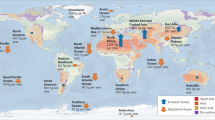Abstract.
During glacial periods, dust deposition rates and inferred atmospheric concentrations were globally much higher than present. According to recent model results, the large enhancement of atmospheric dust content at the last glacial maximum (LGM) can be explained only if increases in the potential dust source areas are taken into account. Such increases are to be expected, due to effects of low precipitation and low atmospheric (CO2) on plant growth. Here the modelled three-dimensional dust fields from Mahowald et al. and modelled seasonally varying surface-albedo fields derived in a parallel manner, are used to quantify the mean radiative forcing due to modern (non-anthropogenic) and LGM dust. The effect of mineralogical provenance on the radiative properties of the dust is taken into account, as is the range of optical properties associated with uncertainties about the mixing state of the dust particles. The high-latitude (poleward of 45°) mean change in forcing (LGM minus modern) is estimated to be small (–0.9 to +0.2 W m–2), especially when compared to nearly –20 W m–2 due to reflection from the extended ice sheets. Although the net effect of dust over ice sheets is a positive forcing (warming), much of the simulated high-latitude dust was not over the ice sheets, but over unglaciated regions close to the expanded dust source region in central Asia. In the tropics the change in forcing is estimated to be overall negative, and of similarly large magnitude (–2.2 to –3.2 W m–2) to the radiative cooling effect of low atmospheric (CO2). Thus, the largest long-term climatic effect of the LGM dust is likely to have been a cooling of the tropics. Low tropical sea-surface temperatures, low atmospheric (CO2) and high atmospheric dust loading may be mutually reinforcing due to multiple positive feedbacks, including the negative radiative forcing effect of dust.
Similar content being viewed by others
Author information
Authors and Affiliations
Additional information
Electronic Publication
Rights and permissions
About this article
Cite this article
Claquin, .T., Roelandt, .C., Kohfeld, .K. et al. Radiative forcing of climate by ice-age atmospheric dust. Climate Dynamics 20, 193–202 (2003). https://doi.org/10.1007/s00382-002-0269-1
Received:
Accepted:
Issue Date:
DOI: https://doi.org/10.1007/s00382-002-0269-1




